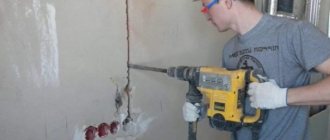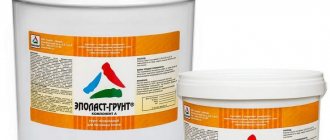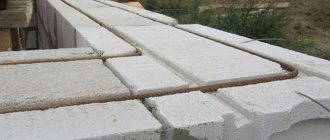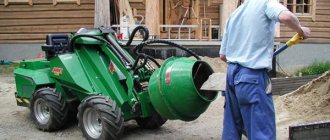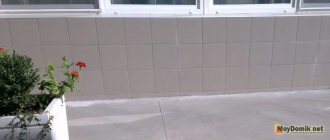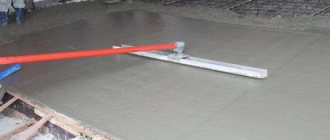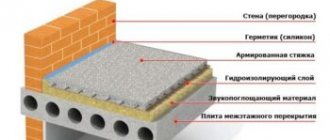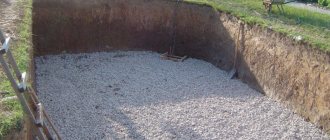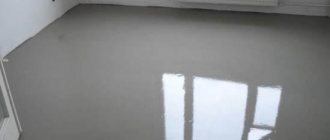I. SCOPE OF APPLICATION
I. SCOPE OF APPLICATION
1.1. A standard technological map (hereinafter referred to as TTK) is a complex organizational and technological document developed on the basis of methods of scientific organization of labor for performing a technological process and defining the composition of production operations using the most modern means of mechanization and methods of performing work using a specific technology. TTK is intended for use in the development of Projects for the organization of major repairs, Projects for the production of repair and construction works and other organizational and technological documentation by construction departments. The TTK is an integral part of the Work Performance Projects (hereinafter referred to as the WPR) and is used as part of the WPR in accordance with MDS 12-81.2007.
1.2. This TTK provides instructions on the organization and technology of work on artificial consolidation of soils using the cementation method.
The composition of production operations, requirements for quality control and acceptance of work, planned labor intensity of work, labor, production and material resources, industrial safety and labor protection measures have been determined.
1.3. The regulatory basis for the development of a technological map is:
– standard drawings;
– building codes and regulations (SNiP, SN, SP);
– factory instructions and technical conditions (TU);
– norms and prices for construction and installation work (GESN-2001 ENiR);
– production standards for material consumption (NPRM);
– local progressive norms and prices, norms of labor costs, norms of consumption of material and technical resources.
1.4. The purpose of creating the TTK is to describe solutions for the organization and technology of construction and installation work on artificial consolidation of soils using the cementation method, in order to ensure their high quality, as well as:
– reducing the cost of work;
– reduction of construction duration;
– ensuring the safety of work performed;
– organizing rhythmic work;
– rational use of labor resources and machines;
– unification of technological solutions.
1.5. On the basis of the TTK, Working Technological Maps (RTK) are being developed for the performance of certain types of work (SNiP 3.01.01-85 * “Organization of construction production”) for the artificial consolidation of soils by cementation.
The design features of their implementation are decided in each specific case by the Working Design. The composition and degree of detail of materials developed in the RTK are established by the relevant contracting construction organization, based on the specifics and volume of work performed.
The RTK is reviewed and approved as part of the PPR by the head of the General Contracting Construction Organization.
1.6. The TTK can be tied to a specific facility and construction conditions. This process consists of clarifying the scope of work, means of mechanization, and the need for labor and material and technical resources.
The procedure for linking the TTC to local conditions:
– consideration of map materials and selection of the desired option;
– checking the compliance of the initial data (amount of work, time standards, brands and types of mechanisms, building materials used, composition of the worker group) with the accepted option;
– adjustment of the scope of work in accordance with the chosen option for the production of work and a specific design solution;
– recalculation of calculations, technical and economic indicators, requirements for machines, mechanisms, tools and material and technical resources in relation to the chosen option;
– design of the graphic part with specific reference to mechanisms, equipment and devices in accordance with their actual dimensions.
1.7. A standard flow chart has been developed for engineering and technical workers (work foreman, foremen, foremen) and workers performing work in the third temperature zone, in order to familiarize (train) them with the rules for carrying out work on artificial consolidation of soils using the cementation method, using the most modern means of mechanization, progressive designs and methods of performing work.
The technological map has been developed for the following scope of work:
– fixed soil – 150.0 m
.
II. GENERAL PROVISIONS
2.1. The technological map has been developed for a set of works on artificial consolidation of soils using the cementation method.
2.2. Work on artificial consolidation of soils using the cementation method is carried out by a mechanized team in one shift, the duration of working hours during the shift is:
2.3. The work sequentially performed during the artificial consolidation of soils using the cementation method includes the following work processes and technological operations:
– geodetic breakdown of the location of driving injectors;
– driving injectors into the ground;
– connection of hoses for injection of solution;
– injection of solution into the soil;
– removal of injectors;
– liquidation of used wells.
2.4. The technological map provides for the work to be carried out by a complex mechanized unit consisting of: a mobile compressor from Atlas Copco XAS 97 Dd
(
compressed air supply 5.3 m / hour, = 0.7 MPa, m = 940 kg);
jackhammer Atlas Copco TEX 09 PS 8461021102
(weight m=9.6 kg, =0.5 MPa, impact frequency 1800 beats/min);
electric grinder PWS 750-125 from Bosch
(P=1.9 kg; N=750 W);
manual injection gas burner R2A-01 with
internal and external mouthpieces, key, O-rings, gas cylinders and reducers;
pipe cutting head REMS Eva;
diesel
mortar pump Putzmeister M 740
(capacity up to 5 m3/hour, =7 bar; total weight m=1450 kg; overall dimensions L W H, 4500 1450 1200 mm).
Fig.1. Injector gas burner P2A-01
a – burner; b – injection device; 1 – mouthpiece; 2 – mouthpiece nipple; 3 – tip; 4 – tubular mouthpiece; 5 – mixing chamber; 6 – rubber ring; 7 – injector; 8 – union nut; 9 – acetylene valve; 10 – fitting; 11 – union nut; 12 – hose nipple; 13 – tube; 14 – handle; 15 – stuffing box; 16 – oxygen valve.
Fig.2. Gas cylinders and reducers
a – oxygen cylinder, volume 6 m3; b – acetylene cylinder, volume 5.32 m; g – oxygen reducer; d – acetylene reducer.
Fig.3. Compressor Atlas Copco XAS 97 Dd
Fig.4. Hammer Atlas Copco TEX 09 PS
Fig.5. Mortar pump Putzmeister M 740
Fig.6. Pipe cutting head REMS Eva
Fig.7. Electric grinder PWS 750-125
Jet grouting of the base
Jet grouting technology, or jet grouting, consists of eroding soil while simultaneously filling the resulting cavity with a solution pure or mixed with the soil mass. This method of strengthening the soil under the foundation can be considered in two ways - as strengthening the soil base with the installation of an impervious curtain and as the formation of a new pile foundation under the old one.
Unlike injection, jet grouting is suitable for almost all types of soil, the result of strengthening is determined with high accuracy. The structure and composition of the soil, as well as the percentage of cement, affect the strength of hardened soil concrete.
Jet cementation is carried out in two stages - first, washout is carried out and a well is formed, and during the reverse stroke of the drill string, a solution is supplied. The diameter of a column made of hardened mortar depends on the type of soil, the force of the applied pressure, the duration of erosion, and the technology used.
Technology options:
- One-component . For erosion, only cement mortar is used, the diameter of the columns is the smallest.
- Two-component . Additionally, compressed air is supplied, the diameter of the columns is approximately twice as large as in the previous case.
- Three-component . Erosion is carried out with a water-air jet, and cement mortar without impurities is pumped into the resulting cavity. The diameter of the columns is the largest, but the strengthening technology is the most complex and requires large-sized equipment.
Many foreign companies have now begun to use high-power compressors for jet cementation. The use of such equipment made it possible to increase the diameter of the columns to 5 meters.
III. ORGANIZATION AND TECHNOLOGY OF WORK EXECUTION
3.1. In accordance with SP 48.13330.2001 “Construction organization. Updated version of SNiP 12-01-2004” before the start of construction and installation work at the site, the Contractor is obliged, in the prescribed manner, to obtain from the Customer design documentation and a permit (order) to perform construction and installation work. Carrying out work without permission (warrant) is prohibited.
3.2. General requirements
3.2.1.
Soil consolidation is the artificial transformation of the construction properties of soils by physical and mechanical methods in the conditions of their natural occurrence to increase strength or cohesion and impart water resistance. As a result of soil consolidation, the bearing capacity of structure foundations increases.
3.2.2.
Consolidation of soils is carried out by injecting binders and chemical solutions into the soil, as well as by exposing the soil to electric current, heating and cooling the soil.
3.2.3.
Depending on the type of means used, the following methods of soil consolidation are distinguished:
– cementation;
– claying;
– bituminization;
– silicatization;
– smolization;
– thermal and electrochemical methods.
3.2.4.
The limits of applicability of each method of fixing soils are determined by the requirements for the fixed soil and the properties of the soils themselves:
– water permeability;
– filtration flow rate;
– soil homogeneity, etc.
These requirements are laid down in the detailed design, and one of the methods for securing soils is proposed.
3.2.5.
Work on consolidating soils must be carried out strictly according to the design, allowing changes and deviations from it only in agreement with the design organization. The project for artificial soil stabilization specifies:
– plan of the building foundations, profile and volume of the soil mass to be fixed;
– layout of injectors and electrodes in plan and sections, driving depth, as well as the number of stops and their location in depth;
– data on the scope of work and control workings;
– data on the amount of chemical solutions for one stop and the entire scope of work, on the mode of injection of solutions and the mode of soil treatment with electric current;
– requirements for fixed soil: strength, solidity, water resistance, water resistance and non-subsidence, fixing radius;
– data on the time required to complete the process and its complexity.
3.2.6.
The simplest and most reliable methods of strengthening soils are cementation, silicatization and electrosilicatization.
3.2.7.
Silication of
soils is carried out with single-solution (sodium silicate - liquid glass, sodium aluminate) or two-solution (liquid glass and calcium chloride) compositions pumped through injectors (perforated pipes with a diameter of 19.38 mm and a length of 1 m) under a pressure of 0.3. 0.6 MPa (3.6 atm). Silication fixes fine and silty sands, quicksand and loess. The radius of soil fixation around one injector is approximately 0.3. 1m.
3.2.8.
Electrosilication
is
used to consolidate clay soils with a filtration coefficient of less than 0.1 m/day.
The essence of the method is that the solution penetrates into the soil simultaneously under the influence of pressure and direct electric current. The soil is strengthened as a result of an electrochemical reaction.
Injection of the base
Strengthening the soil under the foundation by injection involves drilling wells and pumping a strengthening repair composition through injection devices. Under a strip or columnar foundation, wells are drilled obliquely from the surface of the earth; a slab foundation is drilled through from above.
The repair composition under pressure penetrates into all voids adjacent to the well. Constant monitoring of the process is necessary to ensure that the injected material does not go deep. The choice of a specific injection technology is influenced by the type of soil, on which the type of composition depends.
Methods of soil injection:
- Silication . Liquid glass is used for injection. The method is used to consolidate sandy or loess soils and quicksand.
- Smolization . Synthetic fast-curing resins are pumped into wells. The technology is used to strengthen water-saturated or dry sands, loess, sandy loam, and loam.
- Cementation . Wells are filled with a cement-based mortar mixture mixed with clay, loam or sand. Hot bitumen is additionally pumped into large voids. The consistency of the solution is selected taking into account the density of the soil or the size of cracks in the rock. The technology is difficult to implement in fine-grained sands and is completely unsuitable for sandy loam, loam, clayey or silty soils.
- Ammoniation . The method is intended to protect against subsidence of loess soils. Ammonia gas is injected into the soil beneath the foundation, which reacts chemically with the rock.
The injection process occurs without the use of large-sized equipment and does not require partial disassembly or suspension of operation of the building. An additional advantage of injection technology is the ability to lift and return the settled foundation to its original position. In addition to strengthening the foundation, an impervious curtain is created under the foundation for rising groundwater.
Strengthening the foundation by cementation (injection)
Even the strongest foundation eventually loses some of its operational properties under the influence of external factors - the load from the building, the influence of layers of soil and groundwater, temperature and climatic conditions, etc. Thus, after seven to ten years of use, the owner may be faced with the question of strengthening foundation, which can be helped by additional cementation.
This method is applicable to supporting foundations and is used in cases where the support or pile has worn out over time and its load-bearing capacity has decreased. Of course, you can completely replace them - however, this process is long and will require a lot of effort and money. Cementation will allow you to put the supports in order without violating the overall integrity of the foundation. Read about what the technology of strengthening foundations with cementation is in our article.
SOIL INJECTION. SYSTEM MATERIALS:
Materials for soil cementation
Resmix IMZ-B
Resmix IMZ-C
Resmix ZL-F
Resmix ZL-FR
Resmix FR
Materials for soil resinization
Resmix AG-N
Resmix P1U
Resmix P2U
Plasticizing accelerator
Resmix FR
How to understand that the foundation needs to be strengthened
In addition to many external factors, rapid destruction of the foundation can be caused by errors during its installation - for example, a solution of the wrong density was used or several solutions were mixed, low-quality materials were used, markings were carried out incorrectly, etc.
An important role is played by waterproofing concrete, as well as compacting the soil before pouring it; Ignoring these measures will lead to rapid displacement of the foundation, especially on heaving soil. As a result, the concrete surface becomes covered with cracks; if the foundation sag under the building, these cracks will increase and soon appear on the walls. The appearance of such damage is the first sign that the foundation needs repair.
You can determine the speed at which destruction occurs using paper tape, attaching it to the surface of the wall across the crack. If it does not break within a week, the faults have stopped expanding, or are expanding very slowly; If the tape breaks within a few days, it’s time to sound the alarm.
Thermal fixing method
This method is applied mainly to low-moisture clay-type soils with a high degree of permeability. It is convenient to use when the expected settlement exceeds the permissible settlement value of the structure.
During heat treatment, the strength of bonds between particles of macroporous soil increases, due to which the soil becomes non-subsidence.
The recommended processing temperature for macroporous clay soil is 300-400 °C. Under such conditions, the composition of the soil skeleton changes rapidly: a significant reduction in clay and lisping particles is observed. There is a real sintering of soil particles among themselves, due to which its bearing capacity increases.
Heat treatment can increase the uniaxial compressive strength of soil up to 100 kg/cm2. In field conditions, this method is carried out using wells with a diameter of 120-200 mm. The larger the diameter, the better the penetration of combustion products into the array being fixed. The maximum depth to which soil can be secured in this way is 20 m.
In order to ensure the possibility of air injection into the drilled wells, they are hermetically sealed with valves. Thus, a combustion chamber is formed inside the soil.
Methods and technology for cementation
Cementation, otherwise known as concrete injection, can be carried out in two ways: internal and through:
- In the first case, wells are drilled into the concrete surface so that the distance from its lowest point to the base of the foundation is at least 30 cm.
- With through cementation, the foundation is drilled entirely - so that the well passes through it at an angle and goes into the ground to a depth of 50 cm. In this way, not only is the structure strengthened and the total number of support points is increased, but the voids under the sole are also filled, making it more resistant to heaving.
The whole process can be divided into the following stages:
- Drilling pits (wells) in places of greatest damage to the foundation. On average, the width of the pits should be one meter per meter; length - equal to the depth of the foundation minus 15-20 cm. In order not to have a serious vibration effect on the entire structure, it is recommended to drill wells with a slight inclination (5 0 -7 0) in a checkerboard pattern. If possible, it is better to drill a hole inside the house - since the destruction is more intense in the central part. It is not difficult to determine their location - pay attention to cracks in concrete and brickwork, as well as crumbling plaster.
- Next, holes are drilled in the concrete into which tubes are inserted for pumping concrete mortar; the pitch of the tubes can be 30-50 cm, diameter - 4-11 cm. The depth is determined by the extent of the destruction, the maximum value for internal injection of concrete is 30 cm less than the depth of the foundation, with a through one 0.5 m more than the depth of the foundation.
- After this, you need to prepare a concrete solution, the consistency of which is significantly different from that used in construction. The ratio of water and cement in it is 0.9 to 1. To pump the mixture into the pit, a conventional pump or a mobile pumping station is used.
- After the absorption level of the solution drops to 3.5 liters per minute, you need to gradually thicken the solution to a water-crushed stone ratio of 0.7 to 1. Now all that remains is to pour out the entire prepared solution, filling the pit to capacity - the material consumption rates are described in detail in the regulatory documents of ENiR. To increase the speed, you can increase the injection pressure, but not more than 0.3 MPa.
The cementation work can be considered completed. The holes filled with mortar are covered with a tarpaulin and left for 48 hours - this is enough time for the concrete to set and harden.
Remember that cementation involves major structural changes to the foundation of the house, which are often unnecessary. For example, if the reason for the subsidence of a building is not damage to the foundation, but elementary errors in construction - for example, incorrect calculation of the load, due to which it began to push through the soil. In this case, the resulting cracks will not spread further, and drilling holes can only worsen the situation. Therefore, if you do not have proper experience in construction, it is better to consult with specialists before starting any work.
Composition of the solution
The proportions and composition of solutions are selected at the design stage based on geological conditions, cementation method, and environmental conditions.
In addition to the brand of cement and the ratios when diluting an aqueous solution, additional compounds added to the solution play an important role. These include accelerators, plasticizers, fibers, and inert additives. The following principle is observed: thinner voids require a more liquid consistency of the solution. If the voids are quite large, sand may be added. The cement mixture is injected under increasing pressure, which must reach a limit value determined at the design stage.
To carry out cementation of foundations, the following special equipment is used: mortar pumps, drilling pumps, cement stations, hoses, pipes, injectors, pressure meters. Pumping equipment is required. If the solution has a thick consistency, use a diaphragm pump. In other cases, a two-piston mud pump is suitable.
